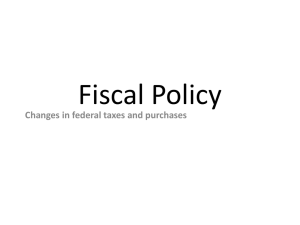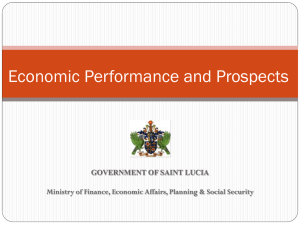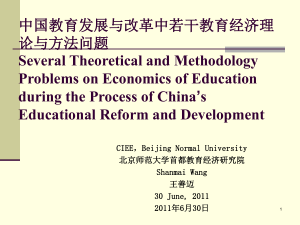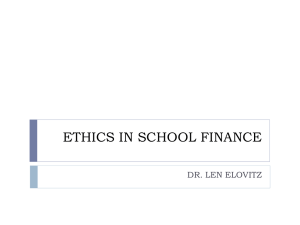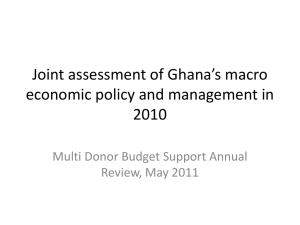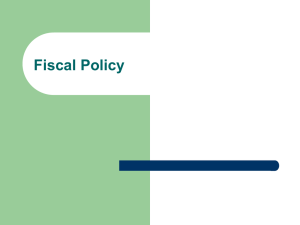Chapter 31
advertisement
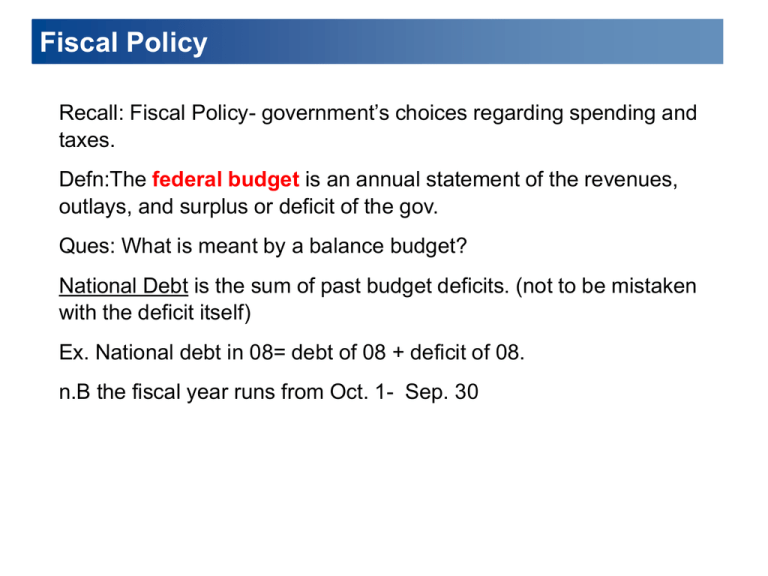
Fiscal Policy Recall: Fiscal Policy- government’s choices regarding spending and taxes. Defn:The federal budget is an annual statement of the revenues, outlays, and surplus or deficit of the gov. Ques: What is meant by a balance budget? National Debt is the sum of past budget deficits. (not to be mistaken with the deficit itself) Ex. National debt in 08= debt of 08 + deficit of 08. n.B the fiscal year runs from Oct. 1- Sep. 30 Fiscal Policy and the Supply Side (Potential GDP) Supply-side effects are the effects of fiscal policy on potential GDP and aggregate supply. Ex. The provision of public goods, labor market incentives (note: reduction in income can create a supply side effect). Recall How does a reduction in income taxes impact the labor market, the full employment level, and potential GDP? Defn: Tax wedge in the labor market is the gap between the before-tax wage rate and the after-tax wage rate. Recall the tax incidence from Econ151. 16.2 THE SUPPLY SIDE AND POTENTIAL GDP The Effects of the Income Tax The income tax 1. Decreases the supply of labor. 2. Creates a tax wedge between the wage rate that firms pay and workers receive. THE SUPPLY SIDE AND POTENTIAL GDP Note: There are other forms of taxes 1) Income tax 2) consumption tax 3) capital gains tax (tax on lending/interest rate tax) These forms of tax add to the tax wedge, reducing potential GDP. How does a tax on consumption impact potential GDP? (hint: A tax on consumption is similar to a fall in real wage rate) It reduces the incentive to provide labor. The total tax wedge = income tax + consumption tax. Ex. Tax on income is 15%, tax on consumption is 10%. What is the total tax wedge? How much goods and services can $100 of income buy? (Assumption: The tax effects are all considered at once.) Tax on Interest Income Recall: real interest rate= nominal rate – inflation. And the real interest rate determines the loanable funds market (what is saved and invested) Point: Capital gains tax are levied on nominal interest rate, savings and investment decisions are made upon the real after tax int. rate. Ex. Suppose interest income tax is 10%. i) Nominal interest rate = 30% and inflation = 5% ii) Nominal interest rate = 45% and inflation= 30% What is the real after tax interest rate? What is the true tax rate? (hint: true rate= tax paid/real interest rate) Income Tax Revenues and the Laffer Curve Laffer curve is the relationship between the tax rate and total tax revenue. As the tax rate rises, tax revenues rise, reach a maximum, and then fall. THE SUPPLY SIDE AND POTENTIAL GDP 1. At a tax of t*, tax revenue is maximized. 2. For tax rates below t*, an increase in the tax rate increases tax revenue. For example, the United States and United kingdom. 3. For tax rates above t*, an increase in the tax rate decreases tax revenue. Perhaps France is an example. Ques 1. The government cuts income taxes. Explain this effect on the supply of labor, the demand for labor, the equilibrium level of employment, and potential GDP. 2.The government increases its outlays but keeps tax revenue unchanged. Explain what happens to savings, investment, the real interest rate, and the growth rate of rgdp. Demand Side Fiscal Policy Discretionary fiscal policy is a fiscal policy action that is initiated by an act of Congress. For example Automatic fiscal policy is a fiscal policy action that is triggered by the state of the economy. For example Cyclical vs. Structural Deficit Total Deficit = cyclical deficit + structural deficit Cyclical deficit – the deficit brought about by automatic fiscal policy Structural deficit- the deficit brought about by discretionary fiscal policy ( for example troubled asset relief program tarp) Why is an increasing deficit and national debt bad? 1) Crowding out effect 2) Dollar devaluation (imports more expensive) 3) Possible higher future taxes How should government stimulate the economy tax cuts or government spending? Multipliers government expenditure multiplier: magnification effect of a change in gov exp on A.D. The tax multiplier is the magnification effect of a change in taxes on aggregate demand. n.b The magnitude of the tax multiplier is smaller than the government expenditure multiplier. The balanced budget multiplier is the magnification effect on a.d of a simultaneous change in government expenditure and taxes that leaves the budget balance unchanged. (Recall a balanced budget) Ques: is the balanced budget multiplier <,>, or = to zero? Expansionary fiscal policy is a discretionary fiscal policy designed to increase a.d. Contractionary fiscal policy is a discretionary fiscal policy designed to decrease A.D Potential GDP is $10 trillion, real GDP is $9 trillion, and 1. There is a $1 trillion recessionary gap. 2. An increase in government expenditure or a tax cut increases expenditure by ∆E. 3. The multiplier increases induced expenditure. The AD curve shifts rightward to AD1. The price level rises to 110, real GDP increases to $10 trillion, and the recessionary gap is eliminated. Potential GDP is $10 trillion, real GDP is $11 trillion, and 1. There is a $1 trillion inflationary gap. 2. A decrease in government expenditure or a tax rise decreases expenditure by ∆E. 3. The multiplier decreases induced expenditure. The AD curve shifts leftward to AD1. The price level falls to 110, real GDP decreases to $10 trillion, and the inflationary gap is eliminated. Limitations of Discretionary Fiscal Policy Law-Making Time Lag The amount of time it takes Congress to pass the laws needed to change taxes or spending. Economic Forecasting Fiscal policy changes take a long time to enact in Congress and yet more time to become effective. So fiscal policy must target forecasts of where the economy will be in the future



